Iron Musashi Tsuba Samurai Katana Blue Dragon Engraved Saya Sharp Japanese Sword —
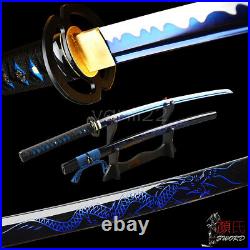
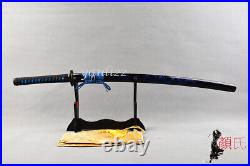
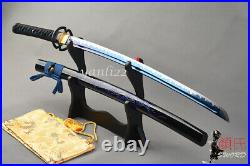

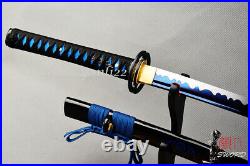
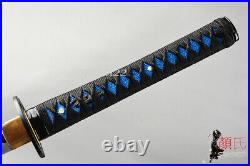
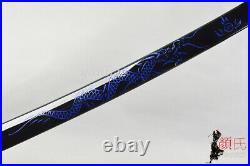
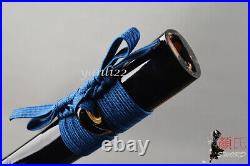
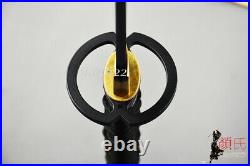
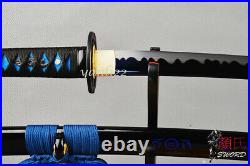
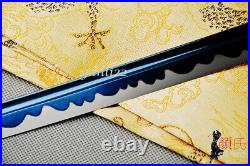
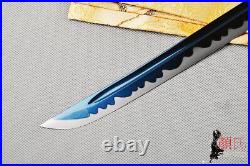

You may also like. Iron Musashi Tsuba Samurai Katana Blue Dragon Engraved Saya Sharp Japanese Sword. This katana can be taken apart fully for maintenance purposes. You can disassemble the sword by taking out the pegs from the handle. We would highly recommend it as a gift. Anyone would be thrilled to receive such a gorgeous katana sword as a gift. Sharp Blue T10 Carbon Steel Blade, HRC 55. Lacquered Wooden Scabbard Engraved with A Blue Chinese Dragon. Synthetic Silk Cord Wrapped Handle with Genuine Ray Skin. Synthetic Silk Cord on the Scabbard. Exquisite Iron Musashi Tsuba. Brass Habaki, Ornate Kashira / Fuchi / Menuki. 1 sword with scabbard. (No display stand or other mountings). Plating (Electroplating) is the use of electrolytic principle in some metal surface on a thin layer of other metal or alloy plating process, is the use of electrolytic action made of metal or other materials adhered on the surface of the parts of a layer of metal film technique to prevent metal oxidation (rust), improve the wear resistance and electric conductivity, reflective resistance, corrosion resistance, copper sulfate, etc. And improve aesthetics, and so on. Plain Black Alloy Kashira & Black Synthetic Silk Ito. Brass Habaki / Seppa & Plain Black Alloy Fuchi. Black Alloy Dragon Menuki, blue Genuine Rayskin Samagawa, 2 Bamboo Mukugi. Blue Synthetic Silk Sageo, Glossy Black Lacquered Saya. Blue Dragon Engraved Saya. Long Bo-hi, Wavy Imitated Hamon. HOW TO DISASSEMBLE A JP SWORD. For engraving English words, Chinese characters and Japanese Kanji. For engraving patterns dragon, lion, etc. Swords can be shaped by a variety of metalworking techniques. The primary techniques are forging and stock removal. Forging uses heat to bring the material to a malleable state. The material is then hammered to shape, typically using hammer and anvil together with specialized set and fuller tools depending on the particular technique. Stock removal shapes the sword from prepared stock that is larger in all dimensions than the finished sword by filing, grinding and cutting. After the blade has been shaped, the sword would be quenched. We quench our swords in either water or oil. Water quenching produces a tougher edge which can also be hardened further more using clay. Blades quenched in oil are still considerably hardened and do have superior flexibility compared to a water quenched blade. The more rapidly a blade cools down, the harder it becomes. Thus, when a hot blade enters the water, the water also gains heat and the blade will cool more gradually. Therefore, the first part of the blade that enters the water will be the hardest. Therefore, the technique of quenching was also very important. If a blade has any flaws from forging (air bubbles, ash), it will break immediately during the quenching process. After quenching, the sword will be quite tough and brittle, with little flexibility. To overcome this, the blade would undergo a tempering process. The blade would be reheated to a certain temperature degree then allowed to cool naturally. The blade would be slightly less tough afterward but have a greater degree of flexibility – the art would be to perfectly balance the blade for toughness, sharpness and flexibility. Finishing encompasses polishing, decorating, and crafting and assembling the hilt, guard and sheath. The swordsmith would be most concerned with the state of the blade itself and possibly decorating the blade and preparing the guards and pommel. Other artisans would likely be involved in the work of fashioning the hilt, sheath and other furniture; and in any fine decoration. When the rough blade is completed, the swordsmith turns the blade over to a polisher, whose job it is to refine the shape of a blade and improve its aesthetic value. The polishing process almost always takes longer than even crafting, and a good polish can greatly improve the beauty of a blade, while a bad one can ruin the best of blades. Early polishers used three types of stone, whereas a modern polisher generally uses seven. On high quality blades, only the back of the blade and the adjacent sides, are polished to a mirror-like surface. To bring out the grain and hamon, the center portion of the blade, and the edge are usually given a matte finish. Microscopic scratches in the surface vary, depending on hardness. Smaller but more numerous scratches in the harder areas reflect light differently from the deeper, longer scratches in the softer areas. The harder metal appears more matte than the softer, and the manner in which it scatters light is less affected by the direction of the lighting. After the blade is finished it is passed on to a mountings-maker for fashioning the hilt, sheath and other mountings. International Buyers – Please Note. This item is in the category “Collectibles\Knives, Swords & Blades\Swords & Sabers\Asian\Japanese”. The seller is “yanli22″ and is located in this country: CN. This item can be shipped worldwide.
- Type: Katana
- Theme: Samurai
- Blade Material: Carbon Steel
- Tang: Full
- Color: Blue
- Edge: Single, Curved
- Handle Material: Cord Wrapped
- Original/Reproduction: Original
- Brand: SJ SHI JIAN
- Handedness: Double-Handed
- Dexterity: Ambidextrous
- Country/Region of Manufacture: China
- Style: Japanese

Categorised as: iron
Comments are disabled on this post